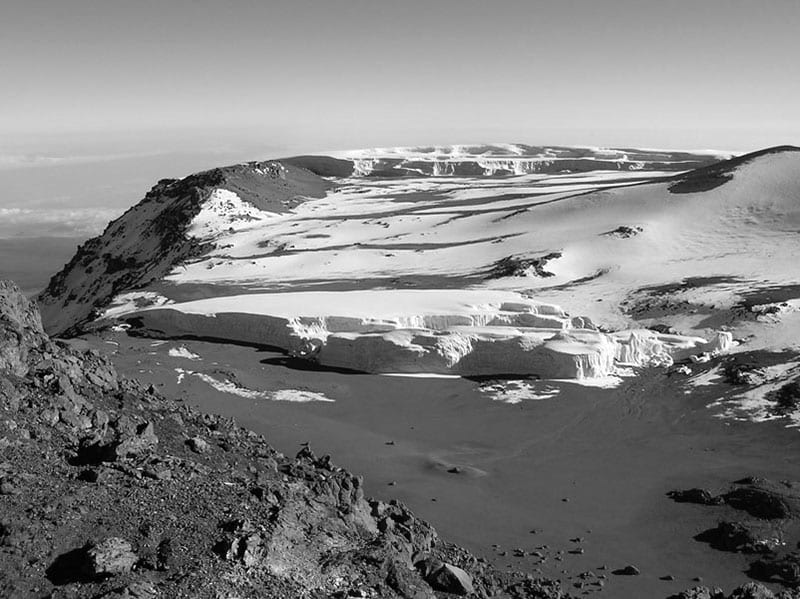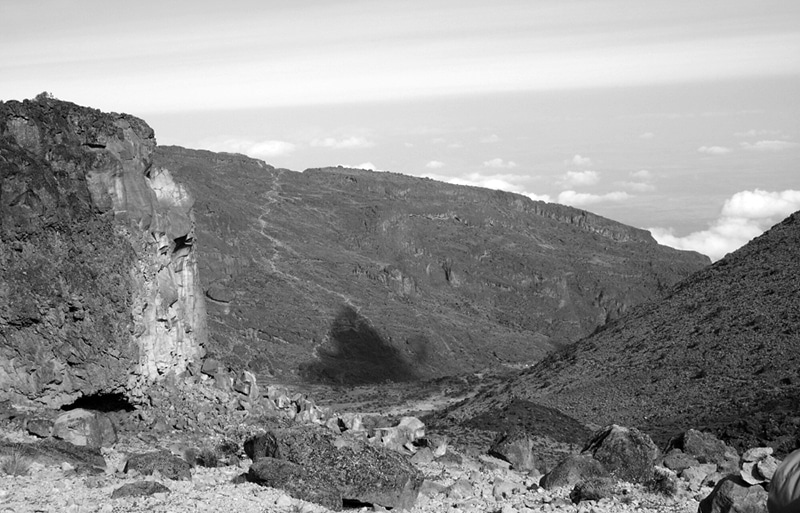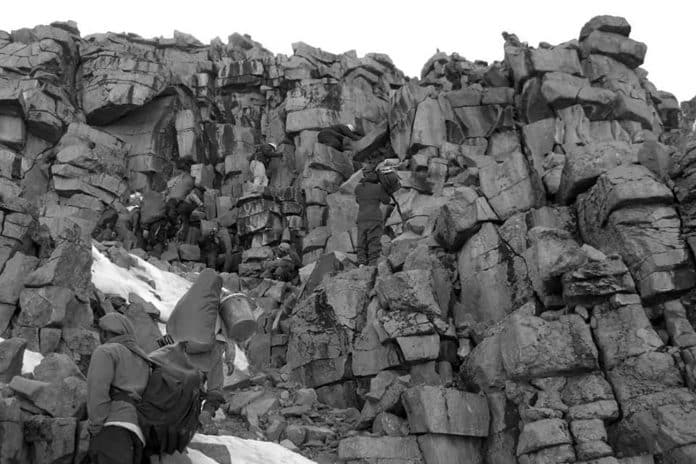Western Breach Kilimanjaro Route – Things You Need to Know
Hiking the Western Breach Kilimanjaro Route
To scale Kibo and reach Uhuru Peak on Mount Kilimanjaro using the Western Breach Kilimanjaro route is the most demanding and treacherous.
The melting glaciers above furnish the greatest danger, not the climb itself. Rocks previously covered in ice are being loosened by retreating glaciers.
The Western Breach Route saw the deaths of three American climbers in January 2006 when a rockfall killed all three climbers. See more details regarding the accident are available here.
The route was closed during the investigation of the incidents. According to the analysis, the course is not safe at this point. There’s a good chance that more landslides will happen. The most dangerous segment of the route was redirected to lower the risk to climbers.
The Kilimanjaro Western Breach Route was eventually reopened. Even though the Western Breach is the most complicated route to climb Kilimanjaro, many organizations and individuals are still prepared to take on the challenge.
What Draws People to the Western Breach Kilimanjaro Route?
The opportunity to attempt something new and different is a big part of appealing to the challenge.
Another feature is that the course travels through a crater wall breach, as the name suggests. Only the Western Breach Route takes climbers deep inside the crater since the other routes only take you to the crater’s rim edges.
Camping in the crater is possible thanks to this western course. The Furtwangler Glacier, Ash Pit, Ernst Reusch Crater, and the Northern and Eastern Ice Fields are accessible to climbers.

The Western Breach course of Kilimanjaro is perilous; hence there is no need to attempt it. The crater and breach can be visible and assessable from above.
Though uncommon on the other Kilimanjaro course, Descents into the crater hole is an option. Some agencies offer a night at the crater camp as an alternative option. This shouldn’t be an issue if you schedule via a private climb.
A crater visit can theoretically be included in the regular climb schedule by descending into the crater and returning to the top on the final day. To drop and look about, you’d need an additional two hours.
This seems reasonable in theory. In reality, you won’t have the stamina, and by the time you reach the top, you’ll be bored to tears. If you still intend to explore inside the crater, make plans and spend the night.
In addition, make sure you have enough time to acclimate to the altitudes while you’re hiking; otherwise, your body won’t be able to handle 5729 meters or 18796 feet above sea level at night.
How Precarious is the Western Breach Kilimanjaro Course?
This Kilimanjaro Western breach route has seen many accidents, but just one being the most tragic has received significant media attention:
Climbers from the United States were making their way to the Western Breach from Arrow Glacier Camp on January 4th, 2006. Approximately 39 tons of rock erupted from the glacier foot 150 meters above them when they were not far from the camp.
As a result of the high winds, it is pretty likely that the climbers were not aware of the approaching rocks until it was too late.
Three climbers were killed, another was seriously injured, and four porters were injured.
Following the investigation, it was found that the glacier’s melting and retreat were to blame for the rockfall. The ice has thawed, allowing the rocks trapped inside to be liberated. However, in this case, a total deposit of rocks exploded.
Other rocks are expected to fall as the glacier melts and retreats. Where rocks will land, however, may be anticipated with some degree of accuracy. The “death zone,” as accident investigators termed it, is a clearly defined area of extreme risk.
This “death zone” has no escape path. Despite this, there was a way to reduce the risk by redirecting the route.
Before that fateful day, everyone who had climbed via the Western Breach Kilimanjaro route had to pass through that dangerous part, traversed by the American team for only an hour or so. The new way cut this time to five minutes.
Even though this is a significant improvement, there is still a risk. According to the investigation team, a single change would increase the danger of rockfalls in a different area.
On Kilimanjaro, the Western Breach is not the only course to see rockfalls. Both of the alternate pathways have seen minor falls as well.
Western Breach course has a far higher risk than the other two.
Other risk factors like the “Rock Steps,” at 5500 to 5600 meters, are considered a “point of no return” for this expedition.
For a rescue or evacuation at more than 5600 meters, the only way out of this situation is Up! The Western Breach Route’s descent would be impractical and time-consuming.
Once reaching that point, even if they are experiencing life-threatening altitude sickness symptoms, they must keep climbing until they get to the rim above and then Barafu.
Is the Western Breach Kilimanjaro Course still your Preferred Method of Ascending Kilimanjaro?
Take a look at the following resources to learn more about accident investigations (PDF) and how to reduce your exposure to risk by making well-informed decisions.
The Western Breach Ascent of Mount Kilimanjaro

The Shira, Machame, Umbwe, or Lemosho pathways lead to the Western Breach. These climbs carry on to Barranco Valley and the Lava Tower on the third or fourth day.
At night on Lava Tower Camp at 4642 meters or 15230 feet, climbers prepare for a Western Breach invasion on the mountain.
Arrow Glacier Camp at 4871 meters or 15981 feet can be reached in around an hour’s hike on the following day. Slowing trekking is necessary to give the body time to adjust.
In terms of the three ascent routes to Kibo, the Western Breach Route Kilimanjaro is the shortest. As a result, your summit night will start later than on the other routes, at the earliest around 2 a.m. and preferably not later than 5.30 a.m. on your route. Rockfall is much more likely to occur if you do anything after that.
A mountain route can only be made shorter by its increasing steepness. Because the other two look more than steep enough, it isn’t easy to imagine.
However, the Western Breach course is not insurmountably challenging despite its reputation. Scrambling, rather than rock climbing, is required for most of the more difficult sections of the trail. The weather has a significant influence on how technical it gets. You may need an ice ax if there is snow on the ground, which you won’t need on any other path.
Western Breach Kilimanjaro route can be attempted by non-climbers who have some climbing experience or at the very least a good deal of caution.
The Western Breach does not have a well-known trail like the other routes. Snow and ice change, stones fall, and the landscape constantly changes. You’ll want to be sure your guide knows where he’s headed!
The Crater Camp is about ten minutes away from the crater’s edge, which takes around four hours to hike to.
There is another problematic ascent from the crater to the summit. In contrast to the Western breach Kilimanjaro, this path is clearly defined. The usual zigzags of the crater wall can be noticed. Switchbacks to Uhuru Peak will take another hour of your time and effort.
Warning Tips: After reaching the crater camp on Kilimanjaro through the Western Breach Path or another route, you should ascend the mountain before spending the night in the crater hole.
Any high-altitude expedition should follow the adage, “climb high, sleep low.” It’s there for a purpose. It helps your body acclimate to staying at this extremely high altitude for long periods without experiencing any adverse effects.
For more articles related to Things to Do in Tanzania (Zanzibar), click here!


































